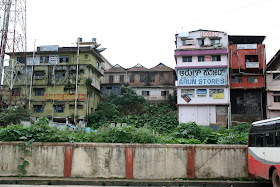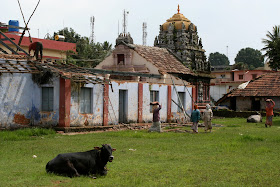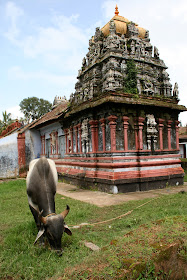
Another day trip from Mysuru. This one pretty much due west, back into the Western Ghats only a couple of hours by bus. The old hill station of Madikeri.

Coming into this part of the mountain range, which just pops right out of the flat plains of south-central India, you can tell pretty much immediately that there is a lot more money in the area compared to Mudumalai. This picture doesn't provide very much evidence of that, what with the corrugated tin roof, cinder block butchers shack (on the left, notice the hanging chickens) and convenience store/pit stop, but there is one hint...note the very nice, clean, professionally made sign advertising the "Coorg Coffee Flower Resort stay". Madikeri is in the Corgu (Coorg) region of the Ghats...one that is very well known for its coffee plantations. Coorg supposedly produces the best coffee in India, and honestly, it wasn't bad (though I'm no aficionado). As most people know, coffee is a cash crop, and it became very evident from looking at the quality of the cars, homes and plantations in the area that many industrious families had capitalized on those delicious, bitter little beans.

Just another reminder of how religion is everywhere in India...this was the mini-shrine at the front of the bus... yes, that is a mini disco light hanging above the picture of Krishna and Radha.

One of the plantations I was talking about...none of the pictures out of the bus turned out very well, since it was pretty bumpy, but still, it gets the point across. So through the electric fence are the low-lying coffee beans. They are shaded by taller trees, most of which are also cash-generating crops, like durian and other fruit trees. The building that is just barely visible in the center here is one of many on the lands... this is a full out plantation, and I'm betting the family that owns it is very rich by Indian standards. To further supplement there income, many of the wealthy families have set up "plantation stays", that is they have turned their plantations into peaceful guesthouses, where wealthy Indians and tourists can pay a premium (again, by Indian standards, really many are quite reasonable for foreign travelers) to stay on the grounds...enjoying fresh, home-grown and made foods, walks through the farm, the cool, fresh mountain air, and just an all around escape from the overwhelming Indian cities.

Of course, this is India, so the dwellings of the not-so-rich are literally just down the road from the obviously wealthy plantations. I guess someone has to work the farms, right? I am immensely frustrated by the ever-growing gap between rich and poor in general, but India magnifies that frustration by displaying such blatant, obvious cases of both extremes literally side-by-side. these buildings are probably two separate one-room homes for two families of people. Stark contrast from the complex of buildings owned and habituated by one family in the plantations. And this isn't even an extreme case... In India, you can find the great many living homeless or in shanty slums just a few short miles from the elite few in their luxurious, massive palaces. I respect Hinduism for many important reasons, however, it is disturbing how it just shrugs off such social differences as simply the result of karma. That screams way too much of opiate for the masses to me...

After a couple hours on the bus, I arrived at the old hill station of Madikeri. This is the scene that greeted me at the central bus station. Indian cities are the prettiest places, but they definitely have character! Madikeri is in the mountains, so it is blessed with some great viewpoints and buildings built right into the landscape.

The family that pees together, stays together. Welcome to Madikeri, to your right, you'll see the central bus station, and to your left, yes, a father and his two children all relieving themselves simultaneously in a public place. Honestly, this is a serious problem in India, you see people evacuating their bladder and/or bowels in public quite frequently... a lot more frequently then most people want to see. Yes, I saw people shit in the streets too...it is disgusting. Watch where you step.

Despite the public defecation family of the year, Madikeri is actually a really, really pleasant town. I was pretty hungry when I first arrived, so I wandered into the city center to get some food. When I'm in a new place and don't feel like just going by what the guidebook tells me, I normally find a place to eat by either just asking a local (if I happen to get into a casual conversation) or employ the fail-safe method of just finding a place that is crowded with locals. I wandered by a place that was obviously packed during the lunch hour, so I decided to go in for a taste. It was a thali place, meaning the menu is fixed. The Indian thali consists of a combination of curries and masalas, served with spicy pickles, yoghurt, papadums (flat, crispy bread), and a large helping of rice. Often, they will have a veg and a non-veg option. In Northern India, the thalis are served in metal trays, with each dish separated by either spacers in the dish or separate metal dishes in the tray itself. In Southern India, your tray consists of a large banana leaf, with the rice in the middle and the various other foods just served around the rice. Of course, the curries, masalas, and even the pickles all vary depending on the region, with the most distinct differences split by the north and south of the country. The best part of thali meals is that they are all you can eat, all for only a few dollars (definitely less than US$5)! Anyway, despite being in the south, this place along the main street was serving their veg thalis on metal trays. It was delicious (as expected based on the crowd), and even though the owner and staff didn't speak any English, they were obviously concerned with my satisfaction with the meal and that I had enough to eat (I ate a ton...it kept coming and I had to literally push the tray away to convey that I was really finished!). It was a great eating experience...as most were in India.

This picture really captures one of the best parts of Madikeri. Unlike in the bigger cities, I found it quite easy to find yourself pretty well alone in Madikeri. It was peaceful, and overall quite pleasant. The mountain air wasn't too hot and felt relatively clean. The colors were nice too...houses and buildings were painted a variety of bright and soft colors. Most of the roofs were tiled as well...that always seems to add a nice feel to a place too for whatever reason.

There were plenty of hotels around town... showcasing again how the region is popular with tourists, both foreign and domestic. Foreigners come year round, but Madikeri is most popular with Indian tourists during the summer months, when the low-lying plains just bake in the sun, experiencing soaring temperatures. They escape to Madikeri and other mountain towns, where the air is always several degrees cooler and shade is easier to come by.

I hope this pic does some justice in explaining why it is such a great little town. It's just pleasant and the surroundings are beautiful. It seems at times more as if you're along the Mediterranean or in Southern California. I found myself just wandering around town, taking it all in and enjoying the relaxing atmosphere.

The people were very, very friendly too! I stopped for a minute to watch this guy fill up the water tank on top of this roof. He was hauling the buckets up one at a time, exemplifying how, often in India, it is simply cheaper to pay a person for manual labor than it is to buy a machine (e.g., a water pump) to do the same task. Anyway, when he looked down and saw me, he got a nice big smile on his face and waved... it was great.

This was one of my favorite sites in Madikeri...this old, old Hindu temple that was in the act of being restored. It was incredibly photogenic.

This was actually at a different construction site (I didn't see if they had one of these posted at the temple too), but it gets the point across. I'm pretty sure this is the demon Shani, a Hindu deity of destruction. As with on the trucks in the Mysuru post, these molds of Shani's head were found posted at most construction sites... I'm guessing to pay respect to the god in an attempt to ward off any destructive forces during the construction process (or in the trucks' mechanics).

Back to the temple site, the Anjaneya Temple... men were busy working on the new roof, while the group of women seen here were hauling supplies (roof tiles and cement maybe?) from the drop-off point by the road to the side of the building. There were a couple of cows just hanging out as well.

This temple was ancient...so it was great to see the restoration work in progress. Its age also really added to its character too, from the dull tones and worn faces and features in the statues to the moss and weeds growing right out of the stone work.

Of course, the cows helped add to the atmosphere too.

Some homes along the lane leading up to the temple. It is scenes like this (and the one below) that made me really, really reflect on everything I have and appreciate it so much more. Similar to most people I'm sure, I often get frustrated about money and possessions. Seeing this though, and just much of impoverished India in general, is a solid slap to my face, making me realize just how lucky I am compared to so many others in the world.

A woman hauling water home. Another thing we take for granted in the world of the wealthy is the immediate availability of clean, fresh water. The majority of people in the world do not have such a luxury. I mean, yes, things are drastically improving, with water delivery systems (tap water) being available in most major cities worldwide now. This isn't true in many slums, though, and despite a tap being available in the home, in most places, the water that comes from it is not safe to drink on its own...it must first be treated. Then there are more rural or poor areas, where people must walk to the nearest source for their water, which again is most often undrinkable and outright unsafe in its raw form. This water must be treated before it is used for cooking or drinking, or else people face the risk of water-borne illness and disease and outright poisoning due to hazardous chemicals. Access to clean, reliable water sources is a major problem, if not THE major problem, in the developing world, and it is just deplorable that such a problem still exists in the world. The international economy has the money and the technology exists to ensure that people worldwide don't have to be plagued by this hazard anymore. If a wealthy country wants to help with international aid, perhaps they should start with helping to provide clean water systems throughout the developing and rural world. However, the worldwide economy revolves on greed and the pursuit of wealth and power, and until that changes (though, I don't think it ever will really...it goes against human nature) people will continue to suffer unnecessarily. It's insane though, since ultimately, people suffering from the lack of clean, accessible water are ultimately hurting the worldwide economy. By having to spend a very, very significant percentage of their time either collecting and treating water or suffering from water-borne health issues, they are not able to participate in the economy as generators and spenders of wealth. I reiterate: it's outright deplorable.

Anyway, back to the brighter side of life. Here is another shot down on Madikeri...with the two main buildings visible here being the new, large Hindu temple (in the central foreground) and the old fort (I think, back up on the hill in the background). Madikeri used to be one of the old British hill stations during the Raj. So it served as a military installation to ensure the native people living in the mountains didn't rise up against the Brits and close off major trade/supply routes. The British found the hill stations particularly appealing due to the naturally cooler climate and beautiful scenery. They poured significant amounts of money into development in and around the hill stations and many English expatriated to these towns further influencing them and promoting development. So it is no surprise that some of the most famously pleasant places around India, those that are often particularly appealing to Western tourists, were former British hill stations.

Outside of the bigger, newer Omkareshwara Temple

I loved these painted lion statues outside of the temple. The symbol in the background is the Sanskrit for "Om", which is what Hindus and Buddhists believe to be the fundamental frequency of the Universe that ties all things together. Ooommmmmmmmm is also the the chant so often associated with Eastern monks.

Looking out of the temple at yet another construction site. These women were hauling these baskets of gravel. As I mentioned in the previous posts...it seemed like there were construction sites all over the place, but nothing was ever new or finished. It was as if certain places and things were in a perpetual state of construction, simply to show that the government or whoever was working on improvement.

I had planned on getting out into the surrounding hills for the afternoon...maybe to visit a plantation or just take a hike. But nature had other plans. By early afternoon, the pleasant skies had turned dark and ominous and I was treated to a pretty epic thunderstorm and downpour. So, changing plans, I just went and found a nice little cafe (turned out to be a Chinese-Indian fusion restaurant, which are absolutely incredible, such explosively delicious food, and pretty popular apparently) and had some small plates of heavily spiced and sauced, stir-fried vegetables and some nice hot chai. I sat the storm out there, just watching out the screened window as it rolled over town.
This comment has been removed by the author.
ReplyDelete